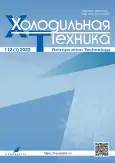Исследование способов локальной криотерапии коленного сустава
- Авторы: Пушкарев А.В.1,2, Саакян Н.Ю.1, Буторина А.В.3
-
Учреждения:
- Московский государственный технический университет имени Н.Э. Баумана (национальный исследовательский университет)
- Российская медицинская академия непрерывного профессионального образования
- Российский национальный исследовательский медицинский университет им. Н.И. Пирогова
- Выпуск: Том 112, № 1 (2023)
- Страницы: 39-47
- Раздел: Оригинальные исследования
- URL: https://ogarev-online.ru/0023-124X/article/view/249465
- DOI: https://doi.org/10.17816/RF607744
- ID: 249465
Цитировать
Аннотация
Обоснование. Локальная криотерапия является перспективным методом лечения заболеваний костно-мышечной системы для облегчения симптомов и восстановления. Для безопасного воздействия с прогнозируемым терапевтическим эффектом для разных локализаций необходим грамотный контроль и прогнозирование процедуры.
Цель работы — выявление измеряемых физических критериев эффективности локальной криотерапии и характеристик для дозирования процедуры, сравнение и анализ возможностей различных способов. В рамках данной работы рассматривается область коленного сустава.
Методы. В эксперименте приняло участие 16 волонтеров, рандомизированных по 4 группам. В первой и второй группе проводили воздействие криопакетами в течение 20 минут. В качестве хладоносителей использовались смесь льда с водой и 23,1% раствор хлорида натрия. Третья и четвертая группа подвергались воздействию азотной (в течение 3 минут) и воздушной (в течение 20 минут) локальной криотерапии, соответственно. Во время проведения эксперимента измерялась температура кожного покрова с помощью датчика температуры и тепловизионной камеры.
Результаты. Наименьшее значение минимальной конечной температуры было зафиксировано после охлаждения парами жидкого азота и равнялось (0,88 ± 1,75) ℃. Минимальная площадь рабочей зоны составила (33,7 ± 7,1) см2. При охлаждении криопакетом со смесью льда и воды наблюдалось наиболее равномерное среди исследуемых случаев распределение температурного поля с наибольшими значениями минимальной конечной температуры (6,43 ± 0,90) ℃ и площадью рабочей зоны (135,2 ± 34,6) см2.
Заключение. Сформулированы основные физические критерии эффективности локальной криотерапии — температура и динамика ее изменения на поверхности объекта воздействия. Предложена и оценена характеристика дозирования — площадь рабочей зоны. Это область, в которой достигается принятая целевая температура. Согласно им, проведено сравнение трех основных способов охлаждения. Целевого результата методы достигают по-разному. Наиболее простыми в применении и подготовке являются контактные способы с использованием криопакетов. Однако, воздушное охлаждение при исследуемом режиме легче переносится испытуемыми, при этом с точки зрения физических критериев, оно эквивалентно контактным способам. Охлаждение парами азота приводит к самому быстрому достижению целевой температуры на поверхности, следовательно, ограничено охлаждение вглубь биоткани.
Ключевые слова
Полный текст
Открыть статью на сайте журналаОб авторах
Александр Васильевич Пушкарев
Московский государственный технический университет имени Н.Э. Баумана (национальный исследовательский университет); Российская медицинская академия непрерывного профессионального образования
Автор, ответственный за переписку.
Email: pushkarev@bmstu.ru
ORCID iD: 0000-0002-1737-7838
SPIN-код: 5796-8324
ведущий инженер, канд. техн. наук
Россия, Москва; МоскваНаталия Юрьевна Саакян
Московский государственный технический университет имени Н.Э. Баумана (национальный исследовательский университет)
Email: natali.saakyan@mail.ru
ORCID iD: 0000-0001-6799-5450
SPIN-код: 4390-3138
студент
Россия, МоскваАнтонина Валентиновна Буторина
Российский национальный исследовательский медицинский университет им. Н.И. Пирогова
Email: avbutorina@gmail.com
ORCID iD: 0000-0001-8465-0593
SPIN-код: 8832-1995
д.м.н., профессор
Россия, МоскваСписок литературы
- Росстат. Здравоохранение в России: статистический сборник. Москва: 2021. № З–46. С. 171.
- Саакян Н.Ю., Пушкарев А.В. Исследование локального криовоздействия на фантоме биоткани // Холодильная техника. 2022. Т. 111, № 3. C. 181–188. doi: 10.17816/RF112350
- Jill A., Selfe J., Rhodes D., et. al. Mapping knee skin surface sensitivity and temperature following cryotherapy // J. Quant. Res. Rehabil. Med. 2019. N 2. P. 1–5.
- Буренина И.А. Современные методики криотерапии в клинической практике // Вестник современной клинической медицины. 2014. Т. 7. С. 57–61.
- Волотовская А.В., Колтович Г.К., Козловская Л.Е., и др. Криотерапия: учеб.-метод. пособие для врачей. Минск: Бел. МАПОБ, 2010.
- Kang J.I., Kim Y.N., Choi H. Effects of Low-intensity Pulsed Ultrasound and Cryotherapy on Recovery of Joint Function and C-reactive Protein Levels in Patients after Total Knee Replacement Surgery // Journal of physical therapy science. 2014. Vol. 26, N 7. P. 1033–1036. doi: 10.1589/jpts.26.1033
- Holwerda S.W., Trowbridge C.A., Womochel K.S., et al. Effects of cold modality application with static and intermittent pneumatic compression on tissue temperature and systemic cardiovascular responses // Sports health. 2013. Vol. 5, N 1. P. 27–33. doi: 10.1177/1941738112450863
- Kim J.S., Mettler J., McCurdy K., et al. Effects of Focal Knee Joint Cooling on Static and Dynamic Strength of the Quadriceps: Innovative Approach to Muscle Conditioning // International Journal of Environmental Research and Public Health. 2021. Vol. 18, N 9. P. 4890. doi: 10.3390/ijerph18094890
- Furmanek M.P., Słomka K.J., Sobiesiak A., et. al. The Effects of Cryotherapy on Knee Joint Position Sense and Force Production Sense in Healthy Individuals // Journal of human kinetics. 2018. Vol. 61. P. 39–51. doi: 10.1515/hukin-2017-0106
- Кульчицкая Д.Б., Фесюн А.Д., Самойлов А.С., и др. Применение физических факторов в программах реабилитации пациентов после тотального эндопротезирования коленного сустава // Вестник восстановительной медицины. 2022. Т. 21, № 2. С. 46–52. doi: 10.38025/2078-1962-2022-21-2-46-52
- Техника и методики физиотерапевтических процедур / Под ред. В.М. Боголюбова. Москва : БИНОМ, 2015.
- Саакян Н.Ю., Пушкарев А.В. Целевая температура локальной криотерапии. Холодильная техника. 2022. Т. 111, № 4. С. 289–295. doi: 10.17816/RF114722
- Разумов А.Н., Григорьева В.Д., Дашина Т.А. Воздушная криотерапия в восстановительном лечении больных остеоартрозом и ревматическими заболеваниями мягких тканей: пособие для врачей. Москва : 2004.
- Chesterton L.S., Foster N.E., Ross L. Skin temperature response to cryotherapy // Archives of physical medicine and rehabilitation. 2002. Vol. 83, N 4. P. 543–549. doi: 10.1053/apmr.2002.30926
- Бычков Е.Г., Храпова К.И., Ковалев А.А., и др. Разработка аппарата для проведения локальной криотерапевтической процедуры ЛАКТ-1000 // Проблемы развития корабельного вооружения и судового радиоэлектронного оборудования. 2015. Т. 4. С. 178–186.
- Ostrowski J. Effectiveness of Salted Ice Bag Versus Cryo-Compression on Decreasing Intramuscular and Skin Temperature // Journal of Sport Rehabilitation. 2017. Vol. 28, N 2. P. 1–22. doi: 10.1123/jsr.2017-0173
Дополнительные файлы










